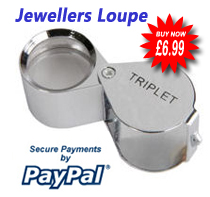You need to know the scrap value - the daily price of gold fluctuates - and also take the historic or antique value into account.
A valuable piece of gold jewellery, made by Cartier for example with have added value because of the design and craftsmanship of the piece.
So, leaving aside designer or antique jewellery how can you assess the carat (or karat) value of a piece of jewellery?
Especially if it does not have a British hallmark?
Remember that the purity of gold is described in units of 24 and refers to the purity and not the weight (as with gemstones).
Gold is always mixed with a base metal and unless it is fine gold (24cts) the actual gold content of a gold ring may vary a great deal between one and another although they may look the same.
The purest gold contains 24 carats and 1 carat of gold is 1/24. However the markings on gold rarely read 18 ct or 9ct for example and instead a number such as 375 or similar.
You can calculate this number into carat value by multiplying by 1000.
9 carats for example means that the purity of gold is 9/24 or 37.5% gold
Multiply 9/24 by 1000 and you get 375 (meaning 37.5) Gold items marked 375 is 9 carat gold.
It works both ways.

So divide 375 by 24% and you will find the carat value. It shows up as 90 (or 9ct) because the truth is that the 375 number is actually 37.5.
Carat value can tell you a lot about the origins of your gold as well as the value.
- 333 or 8ct means that the item is 33.3% gold content. Predominantly Eastern European.
- 375 or 9ct. 37.5% gold content. Mainly of British and commonwealth origin.
- 416 or 10ct. 41.6% gold. USA.
- 500 or 12ct. 50% gold sometimes used in non-British or commonwealth antiques.
- 585 or 14ct. 58.5% gold. Sometimes found in Asian pieces for the export market.
- 625 or 15ct 62.5%. This standard is no longer used but you may find it on vintage pieces pre dating 1935.
- 750 or 18ct. 75% gold and a widely used gold standard.
- 916 or 22ct. 91.6% gold content.
- 999 or 24ct. 99.9% gold content As pure gold as it gets.
Markings to beware of include EP or GP because the P stands for Plate so the gold content is only going to be a few microns thick and added on top of a base metal.
It may have the “look” but not the value. Likewise with rolled gold - an alternative description for gold plate.
You also need to be sure that your piece is not silver with a layer of gold plate so be careful if you come across something that has a number that looks convincing and sounds familiar.
Such as 800, 925 and 950 – very common silver purity numbers.

Buy A Jewellers magnifying Loupe for £6.99
Gold and silver hallmarks main site



